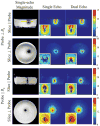Dual-echo Z-shimmed proton resonance frequency-shift magnetic resonance thermometry near metallic ablation probes: Technique and temperature precision
- PMID: 28185304
- PMCID: PMC5552453
- DOI: 10.1002/mrm.26634
Dual-echo Z-shimmed proton resonance frequency-shift magnetic resonance thermometry near metallic ablation probes: Technique and temperature precision
Abstract
Purpose: To improve the precision of proton resonance frequency-shift magnetic resonance thermometry near ablation probes by recovering near-probe image signals that are typically lost due to magnetic susceptibility-induced field distortions.
Methods: A dual-echo gradient-recalled echo sequence was implemented, in which the first echo was under- or over-refocused in the slice dimension to recover image signal and temperature precision near a probe, and the second echo was fully refocused to obtain image signal everywhere else in the slice. A penalized maximum likelihood algorithm was implemented to estimate a single temperature map from both echoes. Agar phantom and ex vivo experiments with and without microwave heating at 3 T evaluated how much temperature precision was improved near a microwave ablator compared to a conventional single-echo scan as a function of slice and needle orientation in the magnet.
Results: The number of near-probe voxels with temperature standard deviation σ>1°C was decreased by 51% in the phantom experiment, averaged across orientations, and by 31% in the pork. Temperature maps near the probe were more smoother and more complete in all orientations.
Conclusion: Dual-echo z-shimmed temperature imaging can recover image signal for more precise temperature mapping near metallic ablation probes. Magn Reson Med 78:2299-2306, 2017. © 2017 International Society for Magnetic Resonance in Medicine.
Keywords: ablation; interventional magnetic resonance imaging; magnetic resonance thermometry; microwave; z-shimming.
© 2017 International Society for Magnetic Resonance in Medicine.
Figures





Similar articles
-
MR thermometry near metallic devices using multispectral imaging.Magn Reson Med. 2017 Mar;77(3):1162-1169. doi: 10.1002/mrm.26203. Epub 2016 Mar 16. Magn Reson Med. 2017. PMID: 26991803 Free PMC article.
-
EPI proton resonant frequency temperature mapping at 0.5T in the brain: Comparison to single-echo gradient recalled echo.Magn Reson Med. 2025 Apr;93(4):1733-1740. doi: 10.1002/mrm.30373. Epub 2024 Nov 11. Magn Reson Med. 2025. PMID: 39529375 Free PMC article.
-
Fast temperature estimation from undersampled k-space with fully-sampled center for MR guided microwave ablation.Magn Reson Imaging. 2016 Oct;34(8):1171-80. doi: 10.1016/j.mri.2016.05.003. Epub 2016 May 20. Magn Reson Imaging. 2016. PMID: 27211258
-
Motion Correction in Proton Resonance Frequency-based Thermometry in the Liver.Top Magn Reson Imaging. 2018 Feb;27(1):53-61. doi: 10.1097/RMR.0000000000000157. Top Magn Reson Imaging. 2018. PMID: 29406416 Review.
-
Proton Resonance Frequency Shift Thermometry: A Review of Modern Clinical Practices.J Magn Reson Imaging. 2022 Feb;55(2):389-403. doi: 10.1002/jmri.27446. Epub 2020 Nov 20. J Magn Reson Imaging. 2022. PMID: 33217099 Review.
Cited by
-
Experimental assessment of microwave ablation computational modeling with MR thermometry.Med Phys. 2020 Sep;47(9):3777-3788. doi: 10.1002/mp.14318. Epub 2020 Jul 16. Med Phys. 2020. PMID: 32506550 Free PMC article.
-
Modeling of active shimming of metallic needles for interventional MRI.Magn Reson Med. 2020 Nov;84(5):2858-2870. doi: 10.1002/mrm.28320. Epub 2020 Jun 29. Magn Reson Med. 2020. PMID: 32597521 Free PMC article.
-
MRI monitoring of focused ultrasound sonications near metallic hardware.Magn Reson Med. 2018 Jul;80(1):259-271. doi: 10.1002/mrm.27034. Epub 2017 Dec 7. Magn Reson Med. 2018. PMID: 29215150 Free PMC article.
References
-
- Comber DB, Barth EJ, Webster RJ. Design and control of a magnetic resonance compatible precision pneumatic active cannula robot. J Med Devices. 2012;8:011003.
-
- Cho ZH, Kim DJ, Kim YK. Total inhomogeneity correction including chemical shifts and susceptibility by view angle tilting. Med Phys. 1988;15:7–11. - PubMed
MeSH terms
Substances
Grants and funding
LinkOut - more resources
Full Text Sources
Other Literature Sources
Medical

